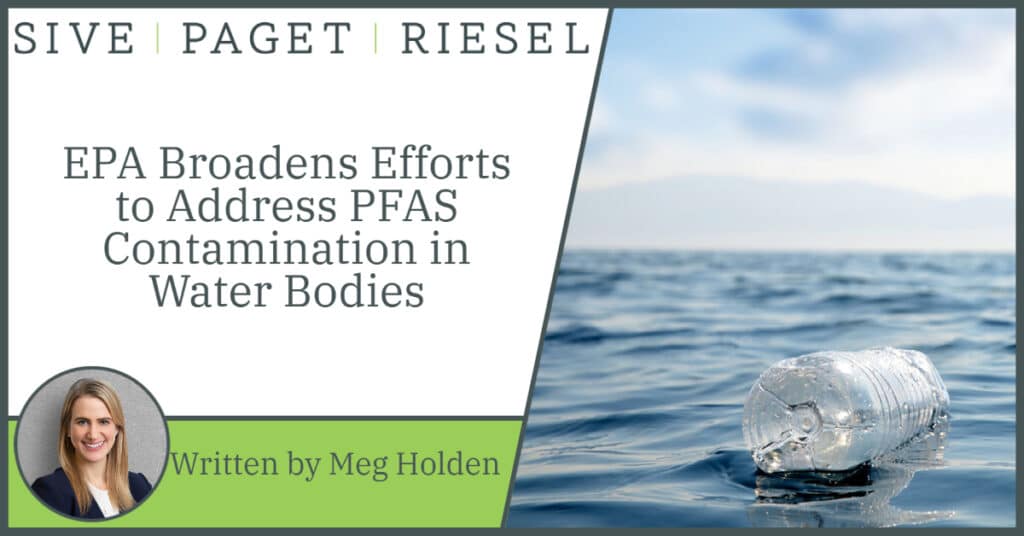Blog

EPA Broadens Efforts to Address PFAS Contamination in Water Bodies
The Environmental Protection Agency (EPA)’s efforts to address contamination by per- and poly-fluoroalkyl substances (PFAS) continue to rapidly evolve. Although federal efforts were initially focused on PFAS in drinking water, EPA has recently begun to address PFAS in a wider variety of sources, including wastewater and stormwater. In April of this year, EPA brought its first-ever Clean Water Act enforcement action to address PFAS discharges in wastewater and stormwater. We can expect that further enforcement actions of this nature are forthcoming, both at the state and federal level.
As detailed in our previous blog post, some of EPA’s recent regulatory efforts include the proposal to classify PFAS as a hazardous substance under the Comprehensive Environmental Response, Compensation, and Liability Act, and a proposed National Primary Drinking Water Regulation under the Safe Drinking Water Act. The April 2023 Consent Order represents EPA’s first attempt to address PFAS through its enforcement authority under the Clean Water Act.
The qualities that made PFAS ubiquitous in many consumer products – including its water solubility and resistance to degradation – also make it easily transmissible via wastewater and stormwater. Wastewater effluent from facilities known or expected to discharge PFAS are often a source of PFAS contamination to water bodies. And when it rains, stormwater can easily pick up and transmit PFAS from structures on and ground surfaces of industrial sites, landfills, wastewater treatment plants, and other facilities where PFAS are present.
EPA and states’ authority to regulate PFAS in wastewater and stormwater is derived from the Clean Water Act (CWA), which prohibits the discharge of pollutants into navigable waters of the United States without a permit. Discharges are permitted through the National Pollutant Discharge Elimination System (NPDES) program, which regulates wastewater effluent and stormwater. The CWA authorizes states to implement the NPDES program, and 47 states currently do so.
EPA has stated that it is working towards developing technology-based and water quality-based effluent limitations for PFAS in NPDES permits, and in the meantime has taken steps to encourage the reduction of PFAS discharges under existing programs. In April 2022, EPA issued a memorandum detailing how it will address PFAS discharges in EPA-issued NPDES permits by including permit requirements to monitor for PFAS and use best management practices like product substitution and good housekeeping, as well as to establish practices to address PFAS-containing firefighting foams in stormwater. In December 2022, EPA updated this guidance and issued a memorandum containing recommendations for addressing PFAS discharges in state-issued NPDES permits. The memorandum recommends a series of provisions that states should include when issuing or modifying a NPDES permit, including, for example, that the permit’s monitoring requirements include PFAS parameters and that stormwater permits include best management practices to address aqueous film foaming foam used for firefighting.
States are following suit and have also started to take action to address PFAS in wastewater and stormwater. As we previously described, New York State has issued water quality guidance values for PFOA, PFOS, and 1,4-dioxane that will be incorporated into requirements for industrial discharges needing a State Pollutant Discharge Elimination System (SPDES) permit under the CWA. New York is also actively working on proposing draft guidance to address PFAS discharged through Publicly Owned Treatment Works (POTWs).
This past April, EPA utilized its enforcement authority under the CWA for the first time to address PFAS in stormwater and wastewater by issuing an administrative compliance order to the Chemours Company for PFAS-related violations of its NPDES permit. Chemours, which uses PFAS in its manufacturing processes, discharges industrial process water and stormwater to the Ohio River and its tributaries under a 2018 NPDES permit issued by the West Virginia Department of Environmental Protection. That permit imposed discharge limitations for two specific types of PFAS: perfluorooctanoic acid (PFOA) and HFPO Dimer Acid (GenX). The permit also required monitoring of these and other pollutants. In its April 2023 Administrative Order on Consent (Order), EPA alleged that the facility exceeded permit effluent limits for PFOA and GenX on various dates from September 2018 through March 2023, and that Chemours failed to properly operate and maintain the facilities and systems required for permit compliance. The Order requires Chemours to implement an approved sampling plan to analyze PFAS and study the presence of PFAS in stormwater and effluent.
We can expect to see more efforts to address PFAS in wastewater and stormwater in the future, both in future enforcement actions at the state and federal level and through EPA’s development of technology-based and water quality-based effluent limitations for PFAS in NPDES permits. Facilities obtaining or modifying their NPDES permits should be aware that PFAS effluent limitations and monitoring requirements may be a component of their NPDES permit.